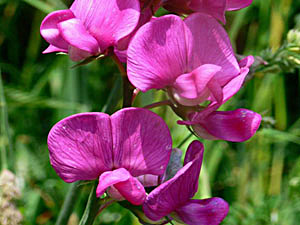
natural herbs
Perennial Sweet Pea
Lathyrus latifolius

Herb: Perennial Sweet Pea
Latin name: Lathyrus latifolius
Family: Leguminosae
Edible parts of Perennial Sweet Pea:
Seed - cooked. Some caution is advised, see the notes above on toxicity. Young seedpod - cooked. Young plant - cooked.Description of the plant:

Plant:
Perennial Climber
Height:
2 m(6 1/2 foot)

Flowering:
July toSeptember
Habitat of the herb:
Hedges, vineyards, fields and uncultivated places.Other uses of Perennial Sweet Pea:
Plants can be grown without supports when they will sprawl on the ground and can be used as a ground cover plant in a sunny position. They should be spaced about 1.5 metres apart each way. They are very vigorous and so are best not used with small plants. They also die down completely in the winter, giving weeds a chance to become established.Propagation of the herb:
Pre-soak the seed for 24 hours in warm water and then sow in early spring in a cold frame. When they are large enough to handle, prick the seedlings out into individual pots and plant them out in the summer. If you have sufficient seed, then it can also be sown in situ in mid spring. Division in spring. It may not transplant well so care should be taken.Cultivation of Perennial Sweet Pea:
Hedges, vineyards, fields and uncultivated places.Medicinal use of the herb:
None knownKnown hazards of Lathyrus latifolius:
Although no records of toxicity have been found for this plant, the seed of some species in this genus contain a toxic amino acid that can cause a severe disease of the nervous system known as 'lathyrism' if they are eaten in large amounts (although small quantities are said to be nutritious). Great caution is advised.Plant information taken from the Plants For A Future.
